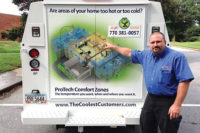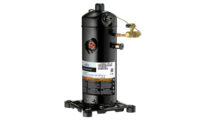In the 1960s, constant-volume reheat systems were considered luxurious. Over time, more and more variable-air volume systems emerged. Even further down the line, zoning, variable-speed compressors, electronically commutated motors, and more have elevated the HVAC industry’s energy awareness.
That concerted energy-saving effort is not only paying off for customers, but for contractors as well.
Efficient Operations
A few years ago, customers weren’t as conscious, or really concerned for that matter, about energy-efficient heating and air systems, said Shawn Montague, president, Breezin HVAC Inc., Staten Island, N.Y.
According to Montague, that has all changed. “It’s a new time and a new generation. People seem to want to be environmentally friendly these days,” he said.
With new, higher-efficiency technology being introduced almost monthly, the game has changed for contractors who sell these units.
“The market has really grown in the last two years,” said Gregg Swenson, owner, Swenson Heating & Air Conditioning Inc., Princeton, Minn. “I’ve seen a large increase in the numbers of homeowners that are better informed on the products prior to having us out to look at their homes, and most are opting to upgrade to 96 percent or better furnaces, and at least 16 SEER air conditioners and heat pumps. In the new construction sector, they are even bringing it to the attention of their builders and realtors on their own.”
Although customer awareness will certainly vary by area and region, the market and demand for energy-efficient and green products is certainly growing in New York. Ellis Guiles, vice president, TAG Mechanical Systems, Syracuse, N.Y., said about half of TAG’s customers are actively seeking efficient units, and for those who aren’t, Guiles said his team members try to steer them down the path to energy efficiency.
“I think the one thing we see with all our clients, especially our residential customers, is that those people who are interested in energy efficiency have felt some pain in the pocketbook,” Guiles said. “That pain has been from either high heating fuel costs or high electrical costs, where they’re paying, in their minds, an outrageous amount. So, those people will be interested in higher-efficiency options to see what they can do to lower their operational costs, and they want to have those conversations.”
Entry Barriers
With energy-efficient units still gaining traction in the mainstream, there remain some barriers to entry — cost being foremost among them. “Money always proves to be the biggest issue,” Montague said. “However, there are all sorts of incentives for choosing energy-efficient systems, including manufacturer rebates, utility rebates, and tax credits, not to mention our customers always have the option to finance, which makes these systems more affordable.”
Guiles, though, doesn’t see cost as being a big reason why customers don’t buy energy-efficient systems. Like Montague, he noted the various incentives and financing options, which helps customers defray costs.
“I don’t see cost as a barrier; it’s more of an educational problem, probably at the contractor level. It’s important that contractors are out there educating consumers on a daily basis, letting them know that it doesn’t cost that much more money. Efficient options are cost-effective, and they provide multiple benefits when all is said and done,” Guiles said. “Maybe the perception of cost is the barrier, because the consumer may think it costs more money to get these things, not understanding that they can be cost-effective.”
Swenson said he thinks homeowners don’t upgrade for two reasons: They don’t have the money and can’t qualify for financing, or the contractor they’ve chosen has failed to reveal the advantages of an energy-efficient upgrade.
“Our customers have been extremely receptive,” Swenson said. “Very rarely do we run across a customer who truly doesn’t want anything except the base system. Sometimes finances can restrict them, but almost everyone wants to be greener and more efficient. Sometimes all it takes is us clearly explaining the options that are available.”
Pitching the upgrade remains a contractor’s best weapon when it comes to energy-efficient HVAC systems.
Guiles mentioned how New York has had an Energy Star program for the last 12 years, which gives them an easy in when discussing upgrades.
“We’re always opening up the conversation with talking about the furnace they have, and then telling them what an upgrade could do for them,” Guiles said. “We discuss the advantages of a comprehensive home assessment, giving them a real idea of truly what’s going on, and how it’s working. Then we tell them how they can benefit by installing an energy-efficient product. Through the process, we lay out all the incentives to help them do that, whether it’s state or federal incentives, and show them how they can actually recoup their savings and how the efficient operation essentially pays for the product.”
Earning an Autograph
Getting customers to sign on the dotted line for a new energy-efficient system can be easier said than done. Montague said it’s important that a contractor’s salesman is not overselling.
“Sometimes you need to make adjustments to the existing ductwork for the high-efficiency equipment to function properly,” he said. “If this occurs, your quoted project suddenly becomes a larger project and carries a larger cost, which your customer may not be comfortable with. Always have your customer’s best interest in mind.”
Swenson said he utilizes a four-pronged approach when it comes to selling efficiency.
“Be very knowledgeable on the products and rebate programs before walking in the door, use technology such as an iPad or tablet to show them the savings in both gas and electric fuel costs, make them understand the added comfort they will achieve for their families, and offer financing as an option,” Swenson said. “This will allow homeowners the flexibility to invest in their homes — even under tight financial restraints.”
Guiles said fellow contractors should remain committed and confident. “I’ve talked to a lot of contractors over the years and their biggest problem isn’t the customer, it’s themselves. I can’t tell you the number of contractors I’ve talked to who said, ‘My clients won’t buy that from me.’ I’m a believer that you get what you believe. If you believe your clients won’t buy, then you’re going to get that result.
“You have to believe your customers will buy this stuff. You’ve got to have that sort of ingrained confirmation inside yourself that says this is the right, good thing to do for your clients, the community, and your business. If you believe those things, then guess what, your customers will come right along with you.”
SIDEBAR: Energy Star Product Finder
Energy Star has launched an online tool that may be useful for contractors who want to pitch energy-efficient products to customers. The Energy Star Product Finder allows users to search for a wide range of products based on energy efficiency. The tool also offers advanced features to support the more complex data analysis required by partners and third parties.
The Product Finder features a basic search, granting users the ability to find products with user-friendly filtering and sorting capabilities, plus a smart keyword search. Users may compare up to four products based on things such as energy efficiency and technical specifications.
The search tool is available now for certified boilers, ceiling fans, commercial ice machines, refrigerators, freezers, water heaters, dehumidifiers, furnaces, geothermal heat pumps, residential refrigerators, room air conditioners, ventilating fans, water coolers, and water heaters. Light commercial HVAC is expected to be added soon. The Product Finder can be accessed at www.energystar.gov/productfinder.
Publication date: 9/30/2013
Want more HVAC industry news and information? Join The NEWS on Facebook, Twitter, and LinkedIn today!










